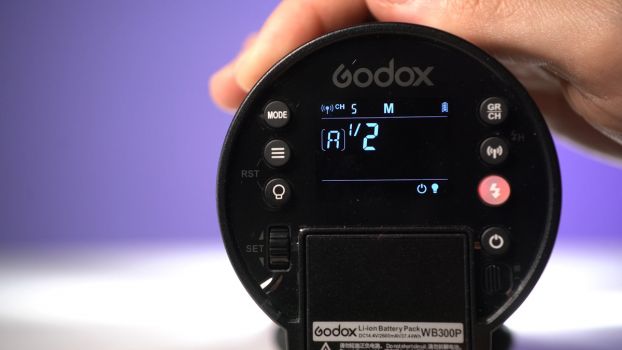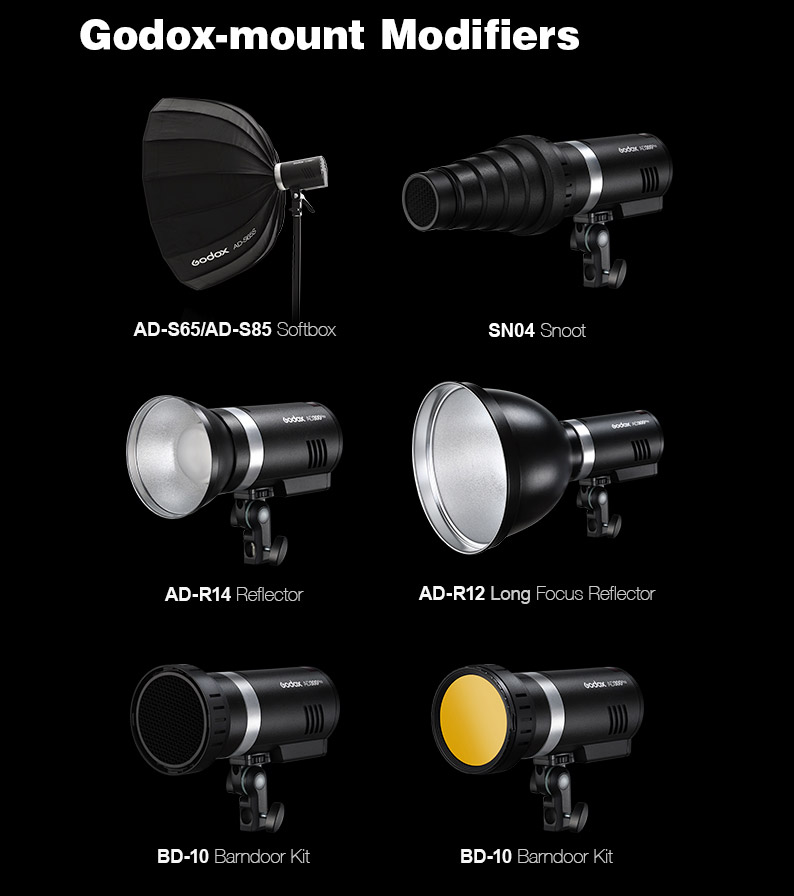I’ve been a Godox user for over 4 years now. In that time there have been three things I’ve learned about the brand. 1 – Godox delivers an exceptional value for the price. 2 – They release products extremely fast. 3 – They are not afraid of cannibalizing their lineup. All of this holds true with the release of their new AD300 Pro. Many will question the need for this light, considering it falls directly between the already popular AD200 and AD400 Pro. However, the AD300 Pro is a departure from Godox’s usual offerings, in that its design is geared towards maximum portability. While I haven’t been able to include this light into my full-time workflow, I’ve had plenty of free time to compare it to their other products and mull over what type of users will benefit most from this new flash.
Size and Weight
Let’s start with the size, which is hard to appreciate from a standalone image. While it’s placed in between the Godox AD200 Pro and AD400 Pro in terms of wattage, the size argument is more complex than that. The AD200 Pro is longer and skinnier, whereas the AD300 Pro is shorter and fatter. The AD200 Pro with bare-bulb is 10x2x3.25″, or 65 cubic inches. The AD300 Pro is 7.5×3.5×4″, or 100 cubic inches. So despite its compact look, the chunky AD300 Pro does take up roughly 50% more space. The AD300 Pro just makes the cut inside my LowePro Photostream SP 200, standing upright just as a large prime lens would.
Including the bulb and battery, the AD300 pro weighs in at 2.7lbs, .6 lbs more than the AD200 Pro. This light payload makes it great for use on a monopod or small stand. Overall, the size and weight difference from the AD200 Pro is very minor. It is considerably smaller and lighter than the AD400 Pro, but what type of power can you expect in this small of a package?
[Related Reading: Godox AD200 Review | One Year and 75 Weddings Later]
Power
I tested the light in an indirect softbox to eliminate the chance of a hot spot influencing the result.
For light output, the AD300 Pro fits directly between the AD400 Pro and AD200 Pro. It was a half stop more powerful than the AD200, and a half stop less powerful than the AD400 Pro, which makes perfect sense.

Interface and Design
The AD300 Pro has a familiar interface, that will have any X series user feel right at home. The first thing I noticed when side by side with the AD200 Pro was how much brighter the AD300 Pro’s display is. This will make setting the group and channel easier when outdoors.
There are buttons on the back to control the group and channel, test fire the flash, a power button, and mode selection, to swap between Manual, TTL, and Stroboscopic. There’s a custom functions menu for controlling details like recycle beep and flash duration display, and a button to turn on the modeling lamp. The dial on the back can be used to adjust the power output. Holding the modeling lamp button will change the display to control the Bicolor LED lamp output, pressing the dial-in allows you to change the color temperature.
Unfortunately, controlling the Bi-color LED lamp can only be done from the AD300 Pro menu, as it’s not currently available on any X Series transmitter. Otherwise, once you set the channel and group, the only reason you should have to touch the display often is to turn the light on and off. The design of the AD300 Pro also leaves the display completely exposed should a drop occur, a lesson I thought Godox learned between the AD200 and AD200 Pro.
While I put little weight in the aesthetics of photography tools, the display and buttons do look dated when compared to the competition.
Battery and Recycle Speed
The WB300P Battery provides 320 full-power flashes and recycles 1/1 in 1 second. While the WB300P battery is new, the AD300 Pro is backward compatible with the AD200 or AD200 Pro battery. However, it’s worth noting that the recycle speed is not quite as fast. By ⅛ power the flash recycles in 1/10th of a second, and below ⅛ power it can keep up with 10 fps for an extended burst. I tested 50 full-power flashes in a row and did not trigger any thermal protection. For this size, the speed at which the AD300 Pro delivers its power is exceptional.
Modeling Lamp
I want to focus on the bi-colour LED modeling lamp, a first for a Godox X series strobe, and no doubt influenced by Profoto’s introduction of the feature on the B10. The AD300 Pro’s modeling lamp color can be adjusted from 3000k to 6000k. Again, this can only currently be done on the strobe itself, not from the trigger. Perhaps this will be added with a firmware update, there’s certainly room for this control on the Flashpoint R2 Pro Mark II. Now, don’t get too excited about this, as it’s only a 12w LED.
In it’s included reflector, at 2 feet away, the modeling lamp metered at F/2 +.2, at 1/250s and ISO 400. This means just over F/1.0 at ISO 100. It’s extremely dim, and that’s when it’s close, using a reflector. In any type of softbox, it’s going to be even less bright, and less useable. Some might wonder if this will function as a video light, and I just don’t see it being very useful. Not only because of it’s low brightness, but also the fan creates a fair amount of noise when the LED is on max power. At most I imagine you’ll be able to use the LED for lighting close detail shots and getting focus in dark environments.
I will give credit to Godox for improving the light quality of this modeling lamp. It has a CRI average of 95.4, which means it does a decent job at accurately representing colors, and its Kelvin temperature was accurate when testing with my Sekonic C-800 colorimeter.

Color Accuracy
The strobe is equally accurate as the AD200 Pro in it’s stable color mode, at +/-100k. With stable color off it’s +/-200k. Testing with the C-800 colorimeter, I saw color temperatures in the 5900-6000k range with color stable mode on. Stable color mode can be turned on or off in the custom functions. When off, the flash durations are shorter.
The CRI of the flash is very high at 97.9, with a CCI green cast of .1. In layman’s terms, this light is extremely neutral and will render colors accurately.
In high-speed sync however, the color temperature drops to the 5300K range, with a CRI of 95 and .4 green cast, which is still acceptable and will only require a minor adjustment. You may find however that when combined with a softbox, especially one with a white interior, that the AD300 Pro in HSS renders a subject overly warm when in a daylight or cloudy environment.
T.1 Flash durations.
If you turn it on in the custom functions, the AD300 Pro will display T.1 flash durations on the LCD. This figure measures the time it takes for the flash to drop from its peak brightness to 10% of its peak brightness. It’s useful for determining how well the flash can freeze motion at a given power setting.
I tested the flash durations using the Sekonic L-858d-u light meter, and the results were all better than the figures Godox includes on the display.
1/256 : 1/12,000
1/128: 1/9460
1/64: 1/7660
1/32: 1/5850
1/16: 1/4400
⅛: 1/2810
¼: 1/1670
½: 1/805
1/1: 1/280

[Related Reading: Westcott Announces The FJ400 – Beating Godox At Their Own Game To Become The “Best Value Strobe”]
Technical Specifications of the Godox AD300 Pro
- Flashpoint Model XPLOR 300Pro TTL
- Power 300Ws
- Compatible Cameras w/R2 Wireless Radio Canon, Nikon, Sony, Olympus, Panasonic, Pentax and Fujifilm
- Flash Mode TTL/M/Multi
- Flash Duration 1/220 to 1/11490 seconds
- Power Output 9 Stops: 1/256~1/1
- Controllable Slave Groups 5 (A, B, C, D, and E)
- R2 Reception Range 328ft / 100m (approx.)Channels32 (1~32)
- Wireless ID 99
- Power Supply Lithium Battery pack (14.4v/2600mAh/37.44Wh)
- Recycle time 0.01-1.5s (approx.)
- Battery Level Indicator Yes
- Full Power Flashes 320
- Stroboscopic Flash Up to 100 times, 100Hz
- Flash exposure compensation (FEC) Manual. Adjustable ±3 stops in 1/3 stop increments.
- Sync Modes High Speed Sync (up to 1/8000 second), First-Curtain Sync, and Second-Curtain Sync
- Delay Flash Feature 0.01~30 seconds
- Color Temperature 5600°± 200k
- Stable Color Mode 5600°±75°K Throughout
- Mask Feature Yes / N1 & N2
- Fan Yes
- Audio Beeper Yes
- Modeling Lamp (LED) 3000°K ~ 6000°K / 10 Levels
- Optical Slave Sensor S1 Standard /S2 Smart
- Direct Sync Trigger 3.5mm Sync Cord
- Flash Duration Indication Yes
- Display Dot-matrix LCD Panel
- Wireless Flash Function Slave, off
- Power Sleep Power off automatically after approximately 30~120 minutes of idle operation. User-selectable in Custom Functions.
- Dimension 7.5×3.8×3.4in / 19.0×9.8×8.7cm
- Net Weight (with battery) 3 lb 1oz / 1.4kg
Godox Mount
The AD300 Pro is a bare-bulb flash that uses the proprietary Godox mount (don’t freak out yet) for attaching light modifiers. As of writing, the selection of modifiers for this mount is very limited. At launch you really only have reflectors and collapsible softboxes like the AD-S65 and AD-S85. There are plans for a grid, snoot, gels, and more, but they have yet to hit shelves in the U.S.
However, just like the Godox AD200, there is a bracket available that will make it compatible with any Bowens mount light modifier. For the AD300 Pro, you’ll need the newer S2 Bowens Mount Bracket. Godox has also shown adapters that will attach directly to the AD300 Pro body for Bowens, Profoto, Broncolor, and Elinchrom.
While it’s not yet available for me to test, I have concerns about mounting large modifiers directly to the AD300 Pro body through the use of adapters. The included stand attachment is small and lightweight. I question its ability to support large softboxes, something that is no problem when using the S2 Bracket instead.

Godox AD300 Pro Review | Conclusion
The AD300 Pro is another great blend of power and performance from Godox. I think this light will be most suitable for photographers who are looking to have a minimal lighting kit, such as a single softbox for outdoor portrait sessions. Its weight is easy to manage with an assistant or a small stand with a light sandbag. While some photographers will be fine sticking with the AD-S85 or AD-S65 softbox, those accustomed to a larger variety of light shaping tools will still yearn for the Bowens mount. It is appropriately priced at $499, which is a price level directly between the AD200 Pro and AD400 Pro.
Check Pricing & Availability of the Godox AD300 Pro Here
The Godox AD300 Pro is currently exclusively sold in the U.S. as the Flashpoint Xplor 300 Pro at Adorama.
8.6 Score
Pros
- Compact and powerful
- Great color accuracy
- Fast recycle
- Backward compatible with AD200 battery
- Versatile modifier compatibility
- Fast t.1 flash durations
Cons
- Unprotected display/controls
- Low powered bi-color LED lamp
- No wireless control of LED color temperature
- Small selection of Godox mount modifiers
Final Verdict
The AD300 Pro is another great blend of power and performance from Godox. It's most suitable for photographers who are looking to have a minimal lighting kit.






Get Connected!